Hippeastrum is a member of the Amaryllis family. This genus unites about 90 species. The name of such a plant includes 2 roots of the Greek language, which translate as "rider" and "star". Very often, inexperienced growers mistake this plant for amaryllis. However, it must be remembered that hippeastrum is naturally found in the subtropical and tropical regions of America (including the Amazon basin), and the beautiful amaryllis (representing a monotypic genus) can be found in southern Africa. These two plants are related to each other, they are considered representatives of the same family, but are distinguished into different genera. Such a flower came to Europe in the 16th century, while its first hybrid appeared already in 1799, and it was named Johnson's hippeastrum.
Content
Brief description of cultivation
- Bloom... August to September.
- Illumination... Needs bright light, but it must be diffused. For growing, windows are suitable for south-west, south or south-east orientation.
- Temperature regime... 17 to 25 degrees.
- Watering... At the beginning of the growing season, water is sparsely watered, and after the formation of the peduncle, it is abundantly watered, but preventing stagnation of liquid in the root system. The bottom irrigation method works well.
- Air humidity... It grows at normal air humidity in room conditions.
- Fertilizer... They are fed regularly 2 times a month. From the beginning of the growing season, liquid mineral fertilizers are used for deciduous plants, and after the formation of a peduncle - mineral fertilizers for flowering plants.
- Dormant period... Observed in October – January.
- Transfer... The transplant is carried out 1 time every 3 or 4 years, shortly before the beginning of the growing season, or when the bush finishes blooming.
- Reproduction... By dividing the bulbs, by children and by seed.
- Harmful insects... Scabbards, aphids, spider mites, mealybugs.
- Diseases... Peronosporosis, burn fungus, red rot.
Features of the hippeastrum
Hippeastrum is a flowering perennial bulbous plant. The shape of the bulb is round, in rare cases - conical, it includes a thick short stem and closed scales. Depending on the species, the diameter of the bulb can reach 50–100 mm. They have cord-like roots on the bottom (base), collected in a bunch.Placed in 2 opposite rows, linear leaf plates reach 0.5–0.7 m in length and only 40–50 mm in width. Their front surface is grooved, and the seamy surface is keeled. They have a green color, but in some varieties it can be crimson. The height of the hollow, leafless cylindrical peduncle is from 0.35 to 0.8 m, an umbrella is formed on it, which consists of 2–6 bisexual flowers, reaching up to 25 centimeters in diameter and about 13–15 centimeters long. Tubular or funnel-shaped flowers have long petioles and different colors, for example: deep red, pink, dark red, orange, white, etc. The fruit is an angular or spherical tricuspid box, which contains small seeds. Freshly harvested seeds have a very high germination rate (almost 100%).
If you want hippeastrum to decorate your home, as well as grow and develop within normal limits, then you must definitely remember several features of such a culture:
- Varieties with white or light colored flowers form a small number of germinating seeds.
- In the warm season, this plant is recommended to be transferred to the garden, while it is added to the ground along with the pot.
- The flowering period of this culture, if necessary, can be adjusted, as a result, the flowers will bloom on a certain day. The fact is that during flowering, hippeastrum looks like a gorgeous bouquet, and it can be a wonderful gift for a birthday or any other significant date.
- After opening, each flower withers after 1.5 weeks.
- For forcing, you should choose large bulbs, as they contain a lot of nutrients.
Home care for hippeastrum
Illumination
Window sills with a lot of bright light are suitable for growing hippeastrum, but it must be diffused. Do not let the scorching direct rays of the sun fall on the foliage of the bush. You can put the pot on the sill of the southeast, south or southwest window. The bush is periodically rotated around its axis, so that it retains its compact shape.
Temperature regime
During intensive growth, the plant needs warmth (from 17 to 25 degrees). If there is such an opportunity, then in the warm season, transfer the flower to the street, however, choose a place for him where the risk of stagnation of liquid in its root system is excluded.
Watering
At the beginning of the growing season, watering should be very sparse. When a peduncle forms at the bush, this indicates that its growing season has begun, from that time you need to start gradually increasing the abundance of watering. From the moment the flower arrow appears until the flowers open, watering should be abundant, but make sure that no water stagnates in the substrate. Watering from a pallet or bottom watering is perfect for such a plant. To do this, lukewarm water is gradually poured into the pan until the clod of earth in the container is completely wet. Be careful not to spill liquid on the bulb while watering. When the bush fades, watering is gradually reduced, and as a result, it is completely stopped.
Top dressing
After the height of the peduncle is 12-15 centimeters, the substrate is spilled with a pinkish solution of potassium manganese. And after 4-6 days, the bush will need top dressing using phosphorus fertilizers. In general, you need to feed the flower systematically 1 time in half a month. At the very beginning of the growing season, liquid mineral fertilizers are used for this for decorative deciduous plants. And when leaf plates are formed at the bush, they begin to feed it with fertilizer for flowering plants, which will have a positive effect on the formation of buds.Prepare the nutrient solution correctly, as if it is too high concentration, it can burn the root system of the bush. The leaf plates should always be clean, for this they are systematically wiped with a damp soft cloth or arrange a warm shower for the flower.
Hippeastrum transplant
It is necessary to transplant such a flower infrequently, namely, once every 3 or 4 years immediately, as the bush fades or shortly before the beginning of the dormant period. Particular attention should be paid to the choice of a container for planting, so the distance from the bulb to the wall of the pot should be no more than 20 mm. The approximate composition of a suitable substrate: coarse sand (perlite), humus, leaf and sod land (2: 1: 2: 2). Before proceeding with the transplant, the soil mixture is sterilized. Also, a good drainage layer is made at the bottom of the pot.
It is necessary to transplant the bush by the transshipment method, in this case the risk of accidentally injuring the root system of the flower will be minimal. It should be borne in mind that after transplantation, at least 1/3 of the bulb should rise above the surface of the substrate.
Reproduction of hippeastrum
Such a flower can be grown from seeds or propagated by vegetative methods. For sowing, it is recommended to use freshly harvested seeds, since at this time they have a very high germination capacity. The germination rate of dried seed is only 30%. Seed propagation is very rare, since this procedure is time-consuming and possible only with fresh seed, and in order to get it, you need to resort to artificial pollination. The very process of sowing and growing seedlings is quite simple.
It is much faster and easier to propagate such a flower vegetatively. To do this, it is enough to separate the baby from the parent bulb. This procedure is carried out during transplantation. To separate the children, a very sharp pre-sterilized instrument is used, and the places of the cuts must be sprinkled with coal powder. Then she is planted in an individual pot. For 2 years, even during the dormant period, leaf plates cannot be cut from the bush.
Hippeastrum can also be propagated by dividing the bulb. This procedure is carried out in November, since at this time there are a lot of nutrients in the bulb. To do this, remove the top layer of the soil mixture in the pot so that only the lower part of the bulb is buried in it. Remove the dry outer scales from it and cut off the foliage, while you need to grab a little of the upper part of the bulb. Then it is vertically divided into 4 shares, which should be equal, while the cuts should reach the surface of the soil mixture. In these cuts, spokes made of wood or plastic are vertically installed, in diameter they should reach 50-60 mm, while the parts of the bulbs should not be connected. Continue to care for the bulb as an adult shrub and do not let the earthy ball dry out. After the leaf plates are formed, the bush should be fertilized and then it must be fed in the same way as a normal adult hippeastrum. Next year, in the spring, the bulbs must be divided into parts and planted in separate pots.


Watch this video on YouTube
Dormant period
The dormant period of such a flower begins in September and ends in January. If in the warm season the bush was on the street, then in the fall it is again brought into the room. At the same time, they begin to gradually reduce watering, after a while the leaf plates dry out. When the leaves are completely dry, they will fall off on their own, as soon as this happens, the stem must be completely cut off, and the container should be placed on its side in a dark, dry and cool (from 6 to 12 degrees) place, where it will stay for 1.5–2 months. It is not necessary to water the onion at this time, but again rearrange it on the window only when the dormant period comes to an end.
Flowering hippeastrum
How to make bloom
So that all efforts are not in vain, and your hippeastrum, grown indoors, must bloom, you can resort to one of the tricks:
- Before planting the bulb, it is placed in hot (from 43 to 45 degrees) water for 3 hours. The result of this procedure will be a lush flowering, which will begin just 20 days after planting.
- In August, you need to stop all watering and move the bush to a dark and dry place. It is necessary to return it to the window only in the last days of January, after which they begin to water the flower again. In this case, it will bloom after 4-6 weeks.
- In July, all leaf plates must be removed from the bush, and all watering must be suspended for 4 weeks. After the first watering, the bush must be fed; for this, liquid complex fertilizing is used. In this case, flowers on the bush will appear in August or September.
The reasons for the lack of flowering
In some cases, the bush does not bloom because it lacks nutrients. Since there is very little substrate in the container, the plant draws out nutrients from it very quickly. In this regard, it is very important to feed the flower regularly and correctly. The same applies to watering.
The absence of flowers can also be explained by the presence of pests on the bush, such as mealybugs, spider mites or scale insects.
If the liquid constantly stagnates in the substrate, then rot may appear on the bulbs, and then the plant will definitely not be able to bloom.
Post-flowering care
As soon as the bush fades, it must be prepared for the upcoming dormant period, and the quality of flowering in the next season depends on how correctly and in a timely manner you do it. From the beginning of the second half of September, the bush ceases to be watered completely, and when its dried foliage flies around, and the peduncle is cut off, it should be rearranged in a dry, dark and cool place. There he will stay until the last days of January or the first - February. After that, the container is transferred to the windowsill and again begin to water and feed.
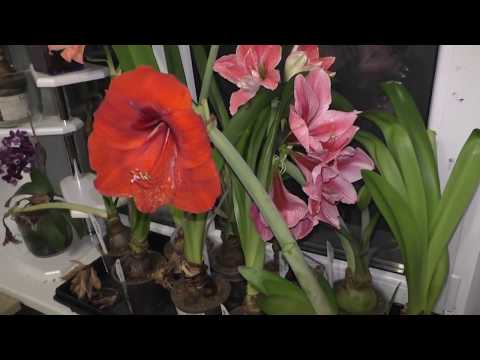

Watch this video on YouTube
Possible problems
Most often, such a flower is affected by downy mildew, red rot and red burn fungus. And also aphids, spider mites, mealybugs and scale insects can settle on it, in order to get rid of them, use a solution of an insecticidal drug.
You can understand what the hippeastrum is affected by by its appearance. If there are red spots on the bulbs and foliage, we can say that the bush is affected by a fungal burn. The appearance of white bloom on the aerial part of the bush indicates the presence of powdery mildew. If the scales of the onion have rotted, and the foliage is hanging, it means that it is affected by rot.
When the hippeastrum is affected by rot, all sore spots and roots must be cut out, the bulb is well dried and planted in a fresh sterilized substrate, but it is pre-treated with foundation. Powdery mildew can be dealt with with special products that can be bought at a specialized store. If a red burn is affected, the bulb must be dug up and all diseased parts must be cut out from it to healthy tissue. Places of cuts must be treated with a mixture consisting of 1 part of copper sulfate and 20 parts of chalk, then it is left in the open air for 7 days to dry. Then it is planted in a new soil mixture, which is pre-treated with a fungicidal preparation.


Watch this video on YouTube

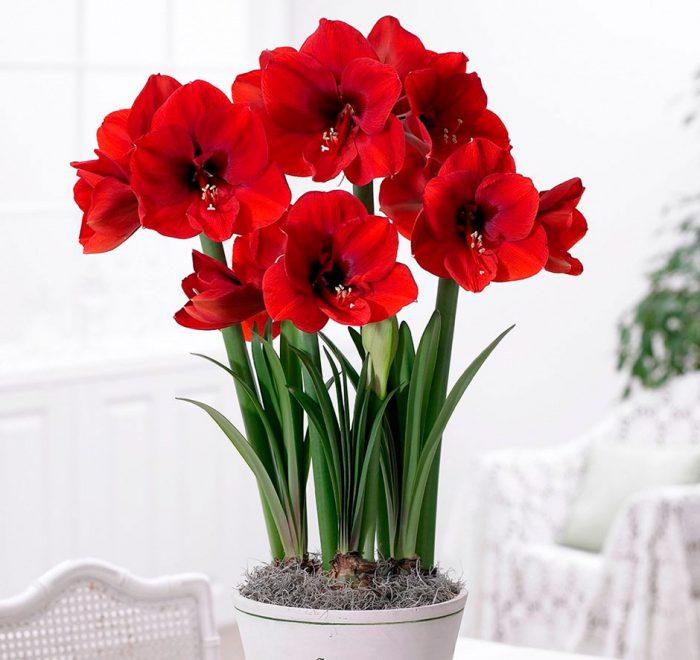
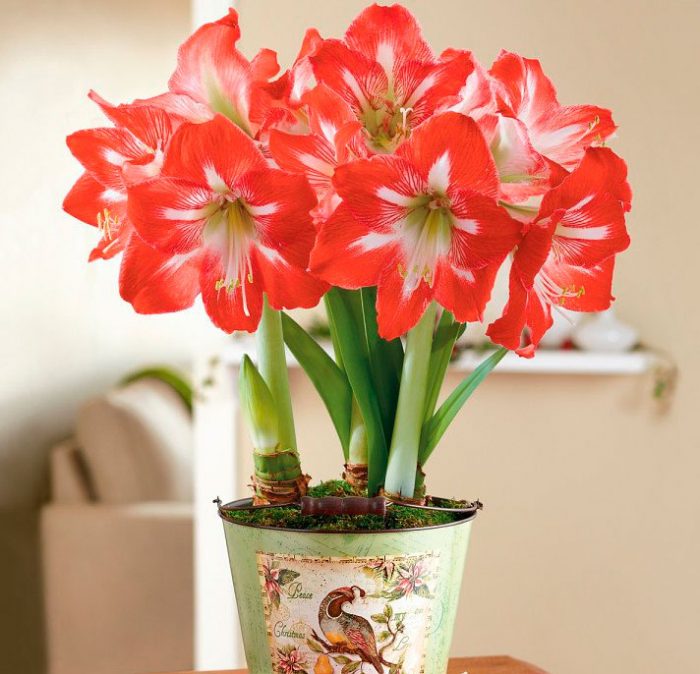
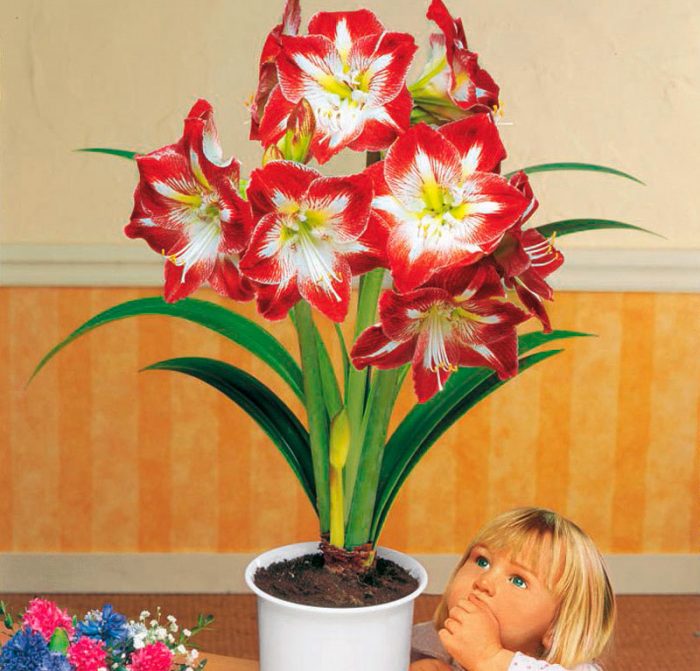
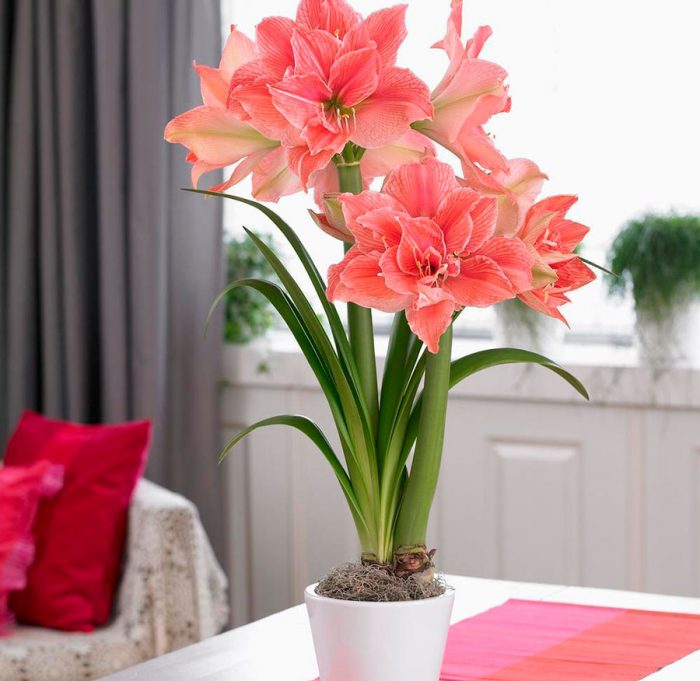
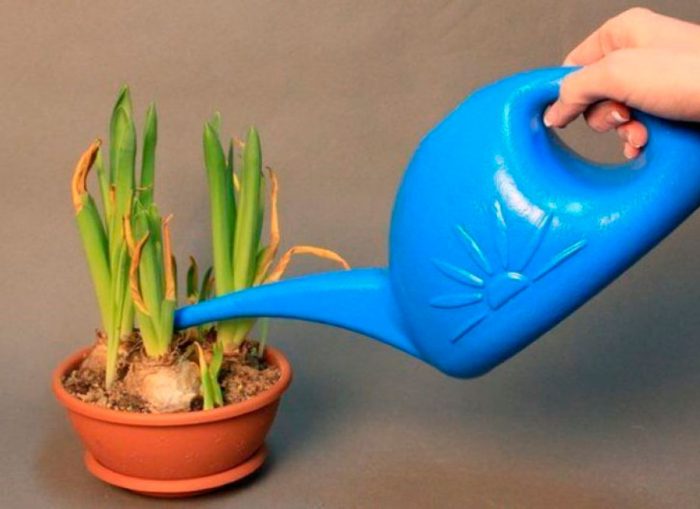
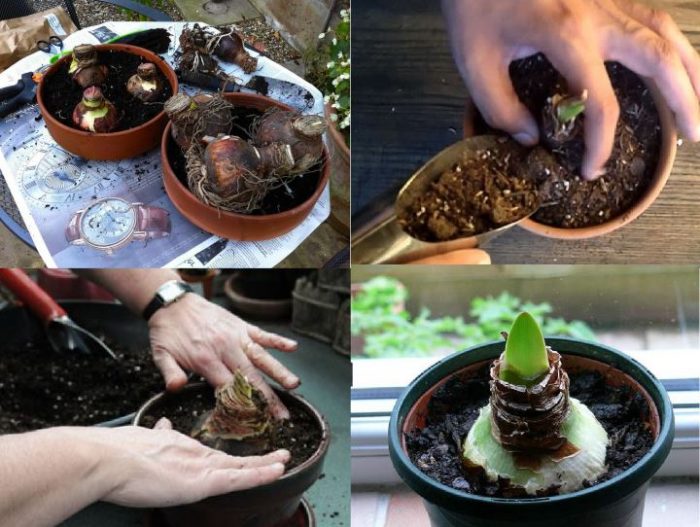
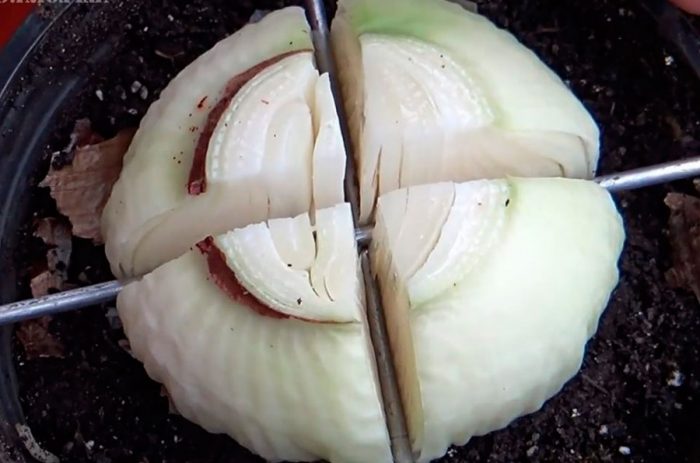
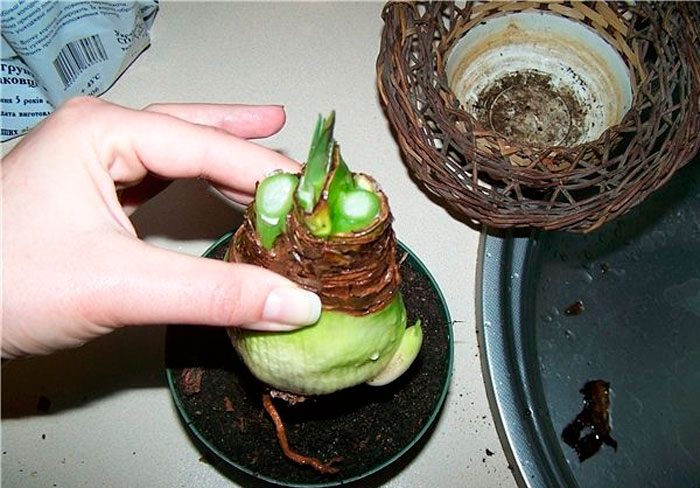
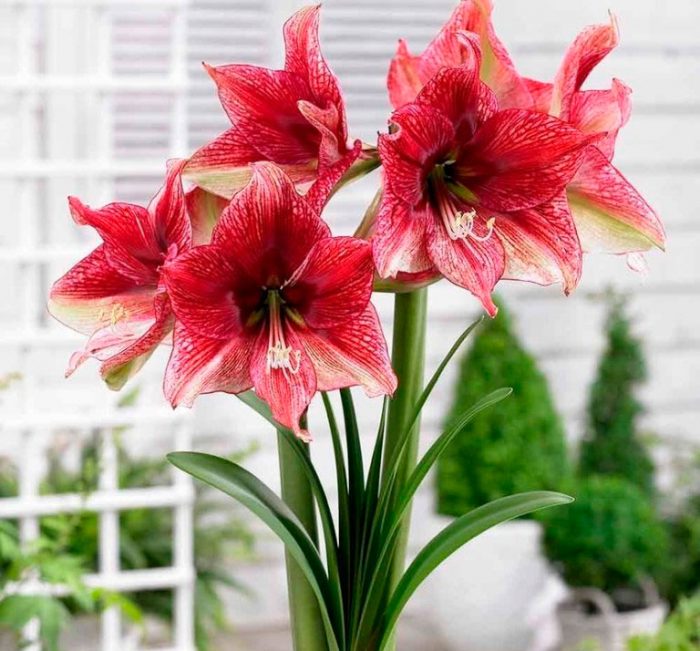
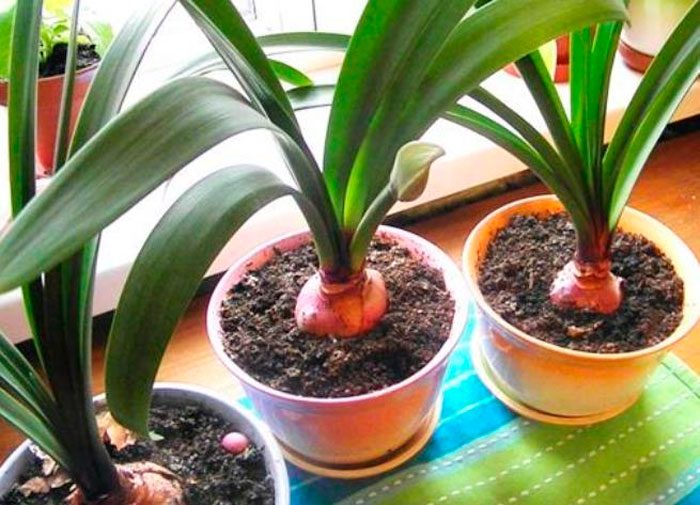
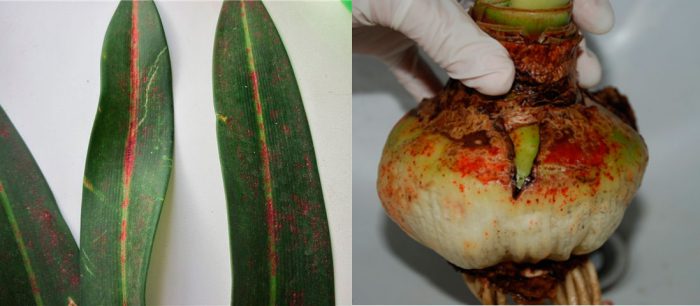
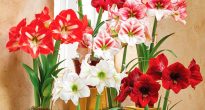

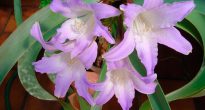


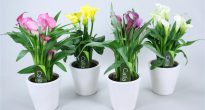




Error on error. And this is repeated on almost every site. Took a shortened version of flower care and reprint it to your taste, thereby misleading people. If they themselves had grown hippeastrum, they would not have written so.Imagine a powerful hippeastrum bush with a freshly faded peduncle: it has 6-8 powerful leaves, a developed root and ... you pull this plant out of the pot to transplant? Delirium - ruin the plant.
Even worse: "immediately after flowering, the hippeastrum cease to water and are taken to rest." It is just beginning to grow, new leaves are creeping, flower buds are laid, and you are on dry rations. With this regime, it will not bloom at all in a couple of years.
Hippeastrum, if it "woke up" at the end of January, will bloom in March, and in April it will already bloom ... and what do you write in "leaving after flowering" - there is generally September! And yes, you cannot cut off the green leaves of the hippeastrum. At first, his month is not watered (in August-September), and then he begins to hibernate himself - the leaves turn yellow and fall off.
Irina, hello! Can you please tell me where you can read more about it? indeed, only brief information is everywhere. And I have 3 pots at work.
Irina, please tell us in more detail when to transplant? And then I read this and think that, probably, you can't put it in hot water for 3 hours, as they advise here ...
Irina, good afternoon. This is my first experience of breeding this plant. Two powerful peduncles have just faded, there are 2 babies. Powerful green foliage. What should I do next? The flower is 3 years old. Due to inexperience, I never entered into a state of rest, because. I didn't even know what this plant is called. Thanks for the answer.
Hello Irina. Your comment is not in the eyebrow, but in the eye ... I experience the same feelings, browsing different sites in search of answers to questions. I broke my head trying to compare the described terms of vegetation, dormancy, leaving p / flowering, etc. - nothing fits. I can't find reliable, competent information that can be used, but the flowers suffer, they need help. I have 4 large bulbs growing in my pot, they bloomed in February. In March, I noticed red stripes of stagonosporosis (red burn) on the leaves, I need to treat it, but I don't know when to start treatment? Do I need to wait for rest, or now take the bulbs out of the pot and process? At the same time, what to do with the affected and healthy foliage, cut or leave it, treated with fungicides? Tell me, please, can you know where you can read serious information? Best regards, Vera. Krasnoyarsk.
Someone can say - is this flower poisonous! My cat chewed it and after 2 days the kidneys failed ... the doctor says that this is poisoning and most likely a daylily somehow ... I really hope that the cat will be cured, but so far in the clinic on a dropper
Irina, advise what to do: hippeastrum faded in April, planted it in the shade in the garden in June, watered it about once a week + rain. Now (August 10) all the leaves have dried up, I dug it up. There are many young roots. But how to store it further? Transplant into a pot of soil and in a dark, dry place? Or store it without land until January, and then plant it in the ground? Your advice is very necessary!
Please tell me. It just faded on March 26th. Trim the peduncle? This is my first hippeastrum, yet I have no experience in caring for it.
Hello, my hippeastrum begins to bloom in January, February, and I don’t remove it from the windowsill at all. I transplant when it has faded, and there is a separate bulb. That's all watering once a week. I love this plant! ?
And what to do with a faded peduncle? Can it be cut or left until it falls off?
Questions about the peduncle. Answer.
I agree 100%. My handsome boy just bloomed yesterday !!!
Hello! Please tell me. The onions were stored for a long time, more than 3 years. Last year they were planted and they began to quickly gain weight, they became larger, lush foliage and children appeared, but now the second year is coming, and there is no peduncle.Hope for flowering or consider it "sterile" and pay attention to the babies, what did the mother's bulb give?
Catherine, hello! Of course, I am not an expert on hippeastrum, but 2 years ago they gave me a bulb with children, during the winter they all grew together on the windowsill, the bulb itself did not bloom, last spring I separated all the children and planted them and the mother's bulb in the garden for the summer, right into the ground , only in partial shade, I watered as I remember, they all grew well and the onions "recovered", in the fall I dug an onion and planted it in a pot, and on the window. At first, the leaves began to dry up, but then new ones began to appear and in March a peduncle grew and 2 flowers bloomed, it's a pity I didn't think to take a picture. And children in separate pots gain weight well). Therefore, I think that children should be separated without fail. Good luck to you!
Thank you for your reply! I will use your experience!
a flower spike appeared, approx. 3 mm, and froze in this state for 3 weeks. What to do? It is on the east window, there is no other.
I have a flower, I don't know its name, the bulb is small, it has been sitting for 7 years and does not grow or die.